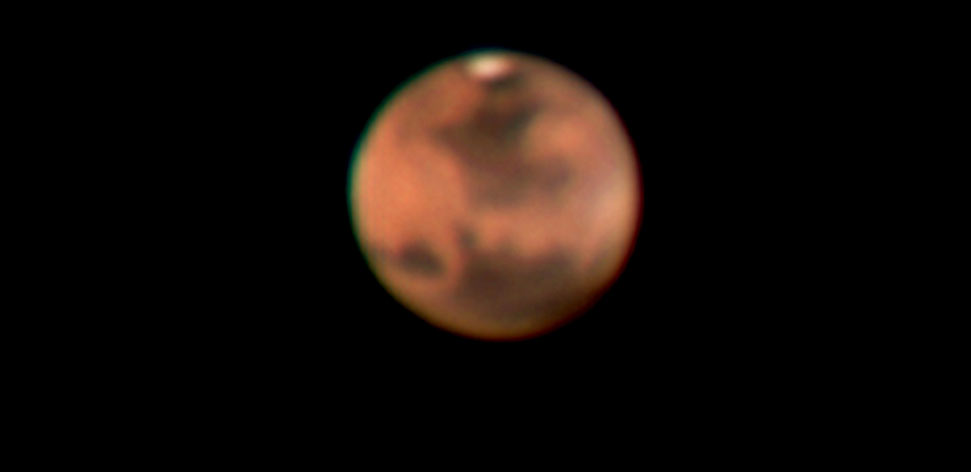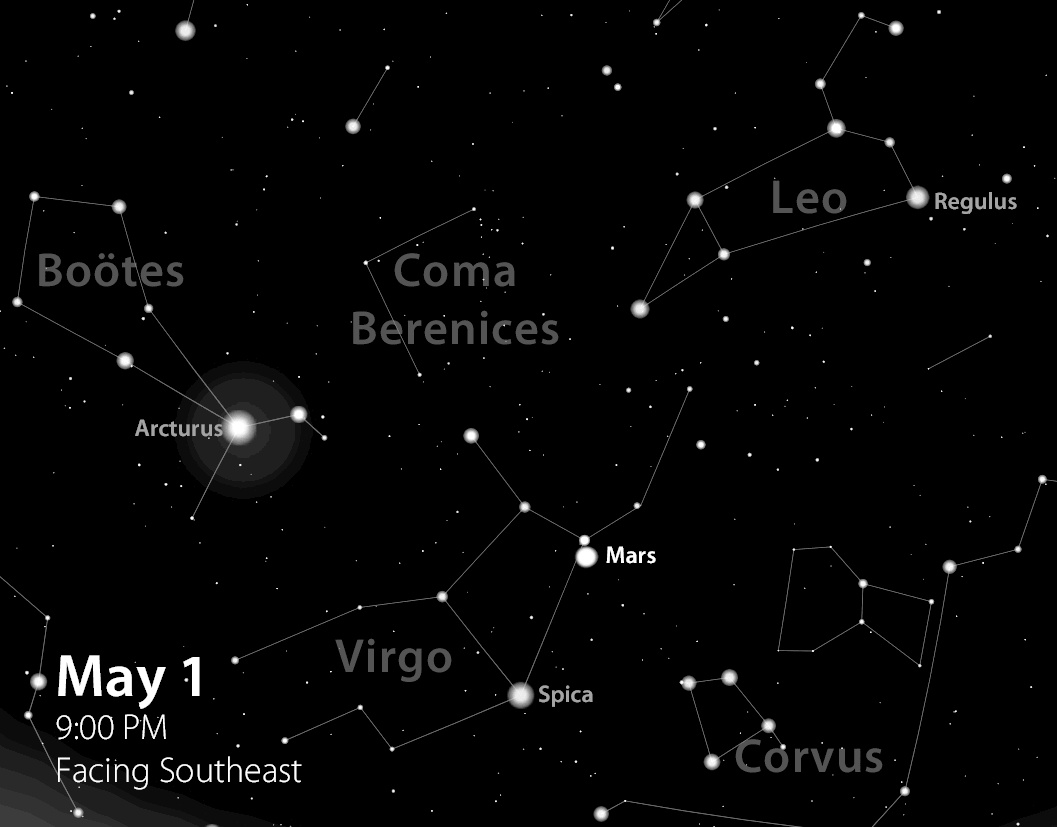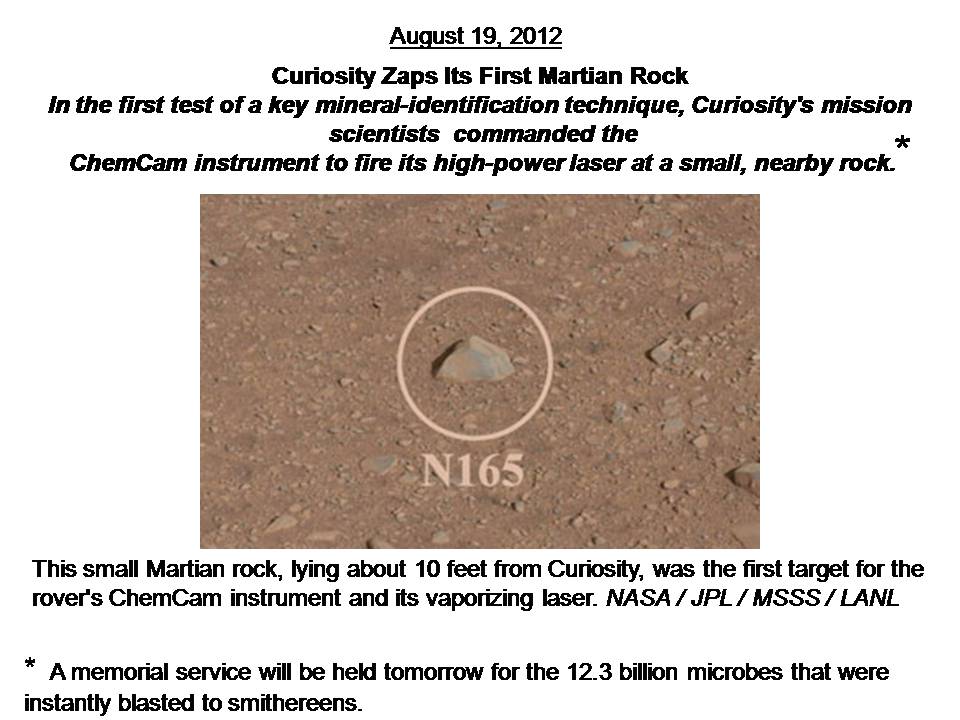
Mars Madness
May 2014 :
I couldn’t resist using that title for this column. While stargazers do not have the fan base like the teams in the NCAA Basketball Championship, we do get excited when we can share views of a world that has stimulated mankind’s imagination for well over a century. I’m referring to our second closest planetary neighbor, Mars. In recent months the Earth had been catching up to Mars, since the Earth orbits the Sun on the inside track (one year) in less time than Mars does (1.88 years). We effectively lapped Mars on April 14 when these two worlds were at their closest for this apparition, which occurs about every 26 months. On that date at 8:54 a.m. EDT, one could look across the 57,406,300 miles of space to observe this dry and barren world almost half the size of the Earth.
For this article I am not going to recount the history of Mars observations or spacecraft explorations other than to say the initial accounts of possible “canals” on Mars at the end of the 19th century captured our imagination and most assuredly hastened our spacecraft exploration of this desolate world. If you would like some historical background, visit Skyscrapers website at http://www.theskyscrapers.org/ and look for an article titled “Mars History Highlights 2012.”
Unfortunately not all Mars close encounters are favorable ones. That fact is due to the eccentricity of Mars’ elliptical orbit and its distance from the Sun. For example, during the previous close encounter on March 5, 2012, Mars and the Earth were a distant 62,652,214 miles from each other. So on April 14 we were about five million miles closer. However, back on August 27, 2003, Earth and Mars were a mere 34,646,418 miles apart, their closest distance for nearly 60,000 years.
You’ll want to begin observing Mars as soon as possible, as the distance between our two worlds will be increasing every day as the Earth pulls away. If you visit one of the local observatories, the volunteers at these facilities will know where to find Mars in the sky. And they will be happy to point it out so you will be able to locate it yourself if you have your own telescope. Should you be unable to take advantage of their guidance, the accompanying star map along with the following brief directions will help you.
 On May 1 at 9:00 p.m. EDT the skies will be dark enough to see Mars residing among the rather indistinct constellation of Virgo. While Virgo’s brightest star Spica (15th brightest in the sky) can be a nice beacon, Mars will be much closer to Porrina which will be just above it. Mars will be the very distinct pumpkin orange colored object shining at about magnitude -1, 40 degrees above the southeast horizon. Do not confuse it with Bootes’ bright orange giant star Arcturus to the left and also about 40 degrees above the eastern horizon. (Several Skyscrapers members have done so in the past, including yours truly!)
On May 1 at 9:00 p.m. EDT the skies will be dark enough to see Mars residing among the rather indistinct constellation of Virgo. While Virgo’s brightest star Spica (15th brightest in the sky) can be a nice beacon, Mars will be much closer to Porrina which will be just above it. Mars will be the very distinct pumpkin orange colored object shining at about magnitude -1, 40 degrees above the southeast horizon. Do not confuse it with Bootes’ bright orange giant star Arcturus to the left and also about 40 degrees above the eastern horizon. (Several Skyscrapers members have done so in the past, including yours truly!)
Once you focus in on Mars with a telescope, the planet will appear as a rust-colored beach ball. As you carefully scan this alien world, you should begin to notice several dark features on the Martian surface. These features are the underlying rock exposed by the shifting sands during intense dust storms. The relatively small image will make it somewhat of a challenge to identify much detail, and the dark surface features may be fleeting. Despite this handicap, a keen-eyed observer should be able to see a dark area like Syrtis Major or a bright one like Hellas Basin. An online utility called Mars Profiler, provided by Sky and Telescope magazine (http://www.skyandtelescope.com/observing/objects/javascript/mars), will help you to identify specific surface features.
While you won’t see any hint of alleged canals, you can still ponder the excitement originally created by such assertions that intelligent Martians were busy irrigating their desert world. For some observers it might be a challenge to observe much detail with a small telescope, but don’t let that situation deter you from gazing at this planet that has stimulated our collective imagination for over a century. And of course the local observatories will be able to share even more Martian detail when steady seeing allows them to “crank up” the magnification on their larger instruments.
The next detail that will hopefully catch your eye will be the North Polar Cap (NPC). It’s a bright white feature that can easily be seen because Mars’ north pole is currently tilted about 21 degrees towards the Earth. It is mid-summer in Mars’ northern hemisphere, so the NPC has had some time to melt. Wait for steady seeing conditions to observe as much detail as possible. The NPC will continue to shrink as the Martian summer progresses, while the Earth/Mars distance increases and the image size decreases.
Keep in mind that Mars rotates once in 24 hours and 38 minutes. That means if you observe a feature at a specific location at a specific time on a given night, you’ll have to wait an additional 38 minutes each successive night for it to be at the same spot, since the Earth rotates once every 24 hours.
Though Mars is noted for producing global dust storms that can enshroud the planet, these storms are usually active when Mars is at perihelion (closest to Sun). The next Mars’ perihelion is not until December, so major dust storms are unlikely during the next few months.
In conclusion, be patient during your observations and note as much detail as your telescope and local weather conditions allow. Take a knowledgeable glimpse of an alien world that inspired generations of astronomers and science fiction writers alike to ponder the existence of Martian life-forms. And don’t forget to take advantage of the marvelous views afforded by the local observatories.
 While there are no (intelligent) Martians, after decades of careful observations of the red planet, we Earthlings have sent an armada of spacecraft to invade “their” world! And perhaps one day in the not too distant future, your children or grandchildren may set foot upon this exciting landscape.
While there are no (intelligent) Martians, after decades of careful observations of the red planet, we Earthlings have sent an armada of spacecraft to invade “their” world! And perhaps one day in the not too distant future, your children or grandchildren may set foot upon this exciting landscape.
If you don’t own your own telescope or the view of Mars through the one you do own is too small to see much detail, plan on visiting Seagrave Observatory (http:/www.theskyscrapers.org) on Peeptoad Road in North Scituate on any clear Saturday night. Or visit Ladd Observatory (http://www.brown.edu/Departments/Physics/Ladd/) located on Hope Street on Providence’s East Side on any clear Tuesday night. Also consider visiting Frosty Drew Observatory (http://www.frostydrew.org/) in Charlestown, which is open every clear Friday night. Visit the respective websites for observing schedules.
Keep your eyes to the skies.
Image of Mars by Steve Hubbard using a 14-inch SCT and ZWO imager on April 19, 2014.



